Multi-Channel Surface EMG Spatio-Temporal Image Enhancement Using Multi-Scale Hessian-Based Filters
Abstract
1. Introduction
2. Materials and Methods
2.1. Model of the MUAP Propagation
2.2. Filter for Enhancing the MUAP Propagation Region
3. Results and Discussions
4. Conclusions
Author Contributions
Funding
Conflicts of Interest
References
- Merletti, R.; Parker, P.A. Electromyography: Physiology, Engineering, and Non-Invasive Applications; Wiley-IEEE Press: Hoboken, NJ, USA, 2004. [Google Scholar]
- Afsharipour, B.; Ullah, K.; Merletti, R. Amplitude indicators and spatial aliasing in high density surface electromyography recordings. Biomed. Signal Process. Control 2015, 22, 170–179. [Google Scholar] [CrossRef]
- Ullah, K.; Cescon, C.; Afsharipour, B.; Merletti, R. Automatic detection of motor unit innervation zones of the external anal sphincter by multichannel surface EMG. J. Electromyogr. Kinesiol. 2014, 24, 860–867. [Google Scholar] [CrossRef] [PubMed]
- Islam, I.U.; Ullah, K.; Afaq, M.; Chaudary, M.H.; Hanif, M.K. Spatio-temporal sEMG image enhancement and motor unit action potential (MUAP) detection: Algorithms and their analysis. J. Ambient Intell. Hum. Comput. 2019, 10, 3809–3819. [Google Scholar] [CrossRef]
- Ullah, K.; Afsharipour, B.; Merletti, R. EMG Topographic Image Enhancement using Multi Scale Filtering. In Proceedings of the XX Mediterranean Conference on Medical and Biological Engineering and Computing (MEDICON 2013), Seville, Spain, 25–28 September 2013. [Google Scholar]
- Huigen, E.; Peper, A.; Grimbergen, C.A. Investigation into the origin of the noise of surface electrodes. Med. Biol. Eng. Comput. 2002, 40, 332–338. [Google Scholar] [CrossRef] [PubMed]
- Soedirdjo, S.D.H.; Ullah, K.; Merletti, R. Power line interference attenuation in multi-channel sEMG signals: Algorithms and analysis. In Proceedings of the 2015 37th Annual International Conference of the IEEE Engineering in Medicine and Biology Society (EMBC), Milan, Italy, 25–29 August 2015; pp. 3823–3826. [Google Scholar]
- Merletti, R.; Muceli, S. Tutorial. Surface EMG detection in space and time: Best practices. J. Electromyogr. Kinesiol. 2019. [Google Scholar] [CrossRef] [PubMed]
- Urbanek, H.; van der Smagt, P. iEMG: Imaging electromyography. J. Electromyogr. Kinesiol. 2016, 27, 1–9. [Google Scholar] [CrossRef] [PubMed]
- Soares, F.A.; de Andrade, M.M.; da Rocha, A.F.; Merletti, R. Automatic Tracking of Innervation Zones Using Image Processing Methods. In Proceedings of the Biosignals and Biorobotics Conference, Vitoria, Brazil, 4–6 January 2010. [Google Scholar]
- Soares, F.A.; Carvalho, J.L.A.; Miosso, C.J.; de Andrade, M.M.; da Rocha, A.F. Motor unit action potential conduction velocity estimated from surface electromyographic signals using image processing techniques. Biomed. Eng. Online 2015, 14, 84. [Google Scholar] [CrossRef]
- Lorenz, C.; Carlsen, I.C.; Buzug, T.M.; Fassnacht, C.; Weese, J. Multi-scale line segmentation with automatic estimation of width, contrast and tangential direction in 2D and 3D medical images. In Proceedings of the CVRMed- MRCAS97, Grenoble, France, 19–22 March 1997; Troccaz, J., Grimson, E., Mosges, R., Eds.; LNCS: Berlin/Heidelberg, Germany, 1997; pp. 233–242. [Google Scholar]
- Du, Y.P.; Parker, D.L. Vessel enhancement filtering in three dimensional MR angiograms using long range signal correlation. J. Magn. Reson. Imaging 1997, 7, 447450. [Google Scholar] [CrossRef]
- Sato, Y.; Nakajima, S.; Shiraga, N.; Atsumi, H.; Yoshida, S.; Koller, T.; Gerig, G.; Kikinis, R. Three-dimensional multi-scale line filter for segmentation and visualization of curvilinear structures in medical images. Med. Image Anal. 1998, 2, 143–168. [Google Scholar] [CrossRef]
- Bovik, A.C.; Clark, M.; Geisler, W.S. Multichannel Texture Analysis Using Localized Spatial Filters. IEEE Trans. Pattern Anal. Mach. Intell. 1990, 12, 55–73. [Google Scholar] [CrossRef]
- Wang, M.; Gao, L.; Huang, X.; Jiang, Y.; Gao, X. A Texture Classification Approach Based on the Integrated Optimization for Parameters and Features of Gabor Filter via Hybrid Ant Lion Optimizer. Appl. Sci. 2019, 9, 2173. [Google Scholar] [CrossRef]
- Conte, L.L.; Merletti, R.; Sandri, G.V. Hermite expansion of compact support waveforms: Application to myoelectric signals. IEEE Trans. Biomed. Eng. 1994, 41, 1147–1159. [Google Scholar] [CrossRef] [PubMed]
- Jacob, M.; Unser, M. Design of steerable filters for feature detection using canny-like criteria. IEEE Trans. Pattern Anal. Mach. Intell. 2004, 26, 1007–1019. [Google Scholar] [CrossRef] [PubMed]
- Schneider, M.; Hirsch, S.; Weber, B.; Székely, G.; Menze, B.H. Joint 3-Dvessel segmentation and centerline extraction using oblique Hough forests with steerable filters. Med. Image Anal. 2015, 19, 220–249. [Google Scholar] [CrossRef] [PubMed]
- Frangi, A.F.; Niessen, W.J.; Vincken, K.L.; Viergever, M.A. Muliscale Vessel Enhancement Filtering. In Proceedings of the First International Conference on Medical Image Computing & Computer-Assisted Intervention, Cambridge, MA, USA, 11–13 October 1998; pp. 130–137. [Google Scholar]
- Nimura, Y.; Kitasaka, T.; Mori, K. Blood vessel segmentation using line-direction vector based on Hessian analysis. In Proceedings of the SPIE in Medical Imaging: Image Processing, San Francisco, CA, USA, 22 February 2010. [Google Scholar]
- Jin, J.; Yang, L.; Zhang, X.; Ding, M. Vascular Tree Segmentation in Medical Images Using Hessian-Based Multiscale Filtering and Level Set Method. Comput. Math. Methods Med. 2013, 2013, 502013. [Google Scholar] [CrossRef]
- Cui, N.; Liu, X.; Yang, S. Multi-Scale Retinal Vessel Segmentation Using Hessian Matrix Enhancement. Int. J. Comput. Sci. Inf. Technol. Res. 2016, 4, 229–237. [Google Scholar]
- Zhou, C.; Chan, H.P.; Sahiner, B.; Hadjiiski, L.M.; Chughtai, A.; Patel, S.; Wei, J.; Ge, J.; Cascade, P.N.; Kazerooni, E.A. Automatic multiscale enhancement and segmentation of pulmonary vessels in CT pulmonary angiography images for CAD applications. Med. Phys. 2007, 34, 4567–4577. [Google Scholar] [CrossRef]
- Lindeberg, T. Scale Space Theory in Computer Vision; Search Results Web results; Kluwer Academic: Dordrecht, The Netherlands, 1994. [Google Scholar]
- Farina, D.; Merletti, R. A novel approach for precise simulation of the EMG signal detected by surface electrodes. IEEE Trans. Biomed. Eng. 2001, 48, 637–646. [Google Scholar] [CrossRef]
- Cescon, C.; Raimondi, E.E.; Zacesta, V.; Drusanystaric, K.; Martsidis, K.; Merletti, R. Characterization of the motor units of the external anal sphincter in pregnant women with multichannel surface EMG. Int. Urogynecol. J. 2014, 25, 1097–1103. [Google Scholar] [CrossRef]
- Marateb, H.R.; Farahi, M.; Rojas, M.; Mañanas, M.A.; Farina, D. Detection of Multiple Innervation Zones from Multi-Channel Surface EMG Recordings with Low Signal-to-Noise Ratio Using Graph-Cut Segmentation. PLoS ONE 2016, 11, e0167954. [Google Scholar] [CrossRef]
- Salah, M.B.; Mitiche, A.; Ayed, I.B. Multiregion Image Segmentation by Parametric Kernel Graph Cuts. IEEE Trans. Image Process. 2011, 20, 545–557. [Google Scholar] [CrossRef] [PubMed]
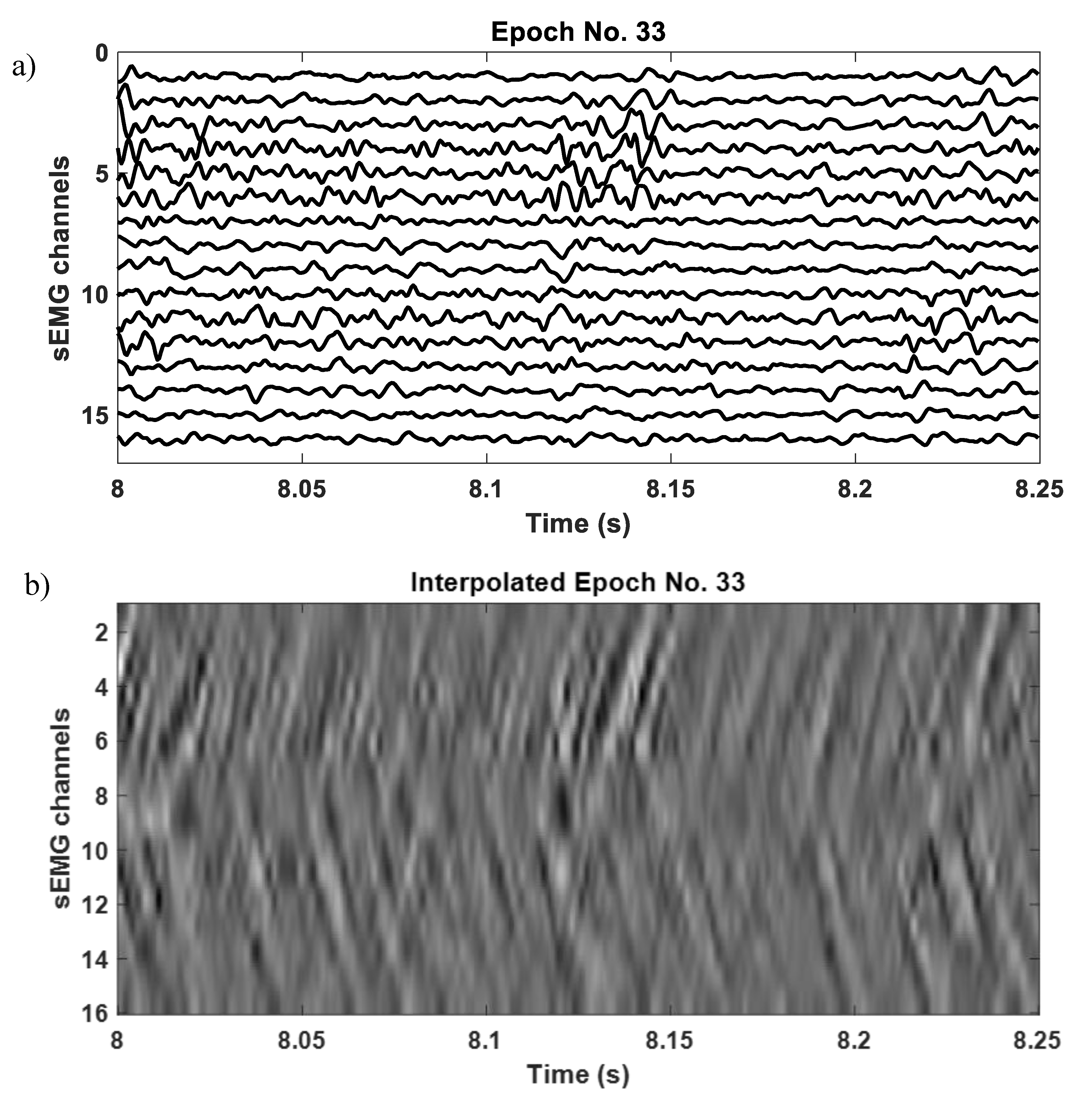
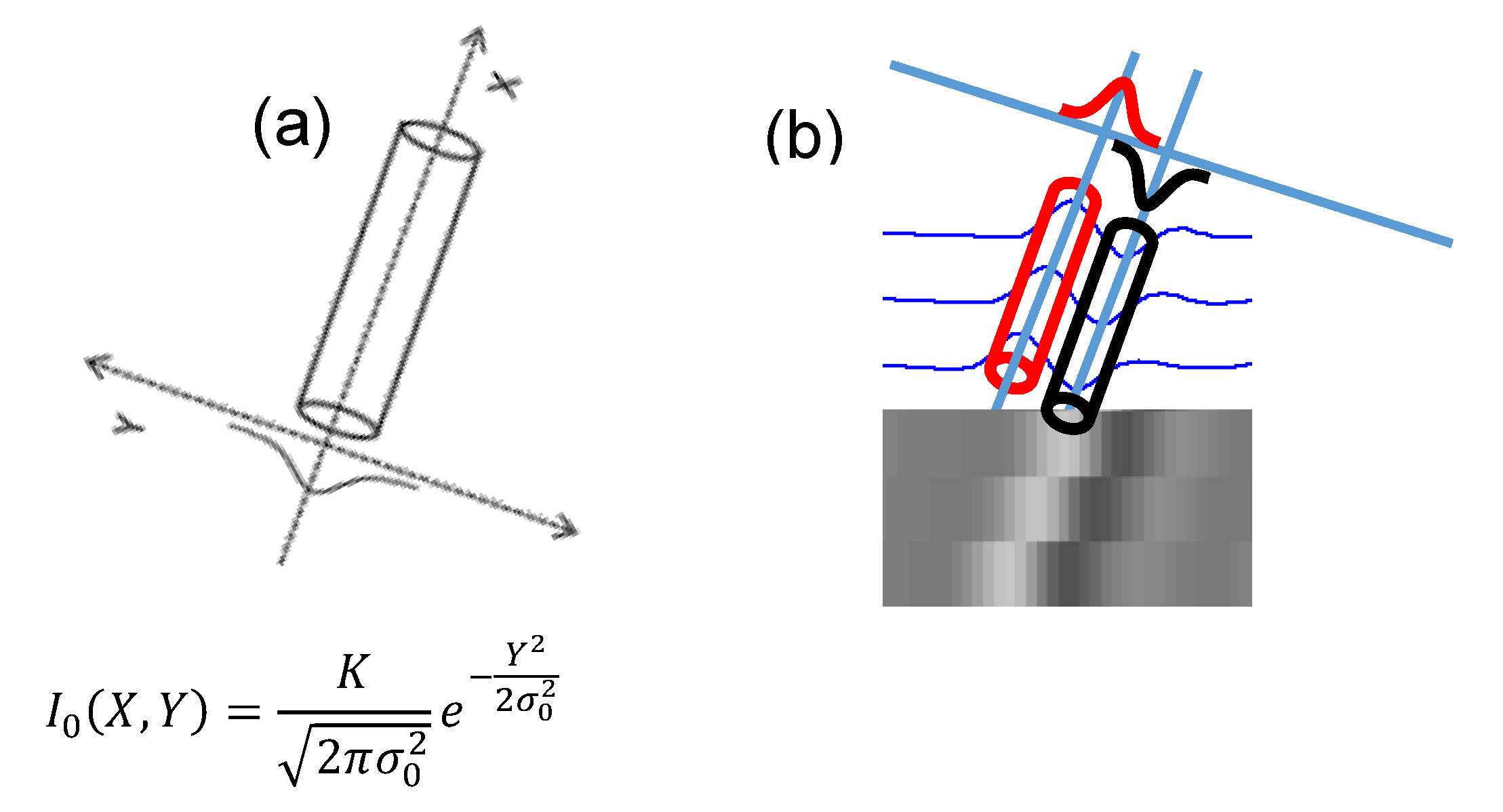
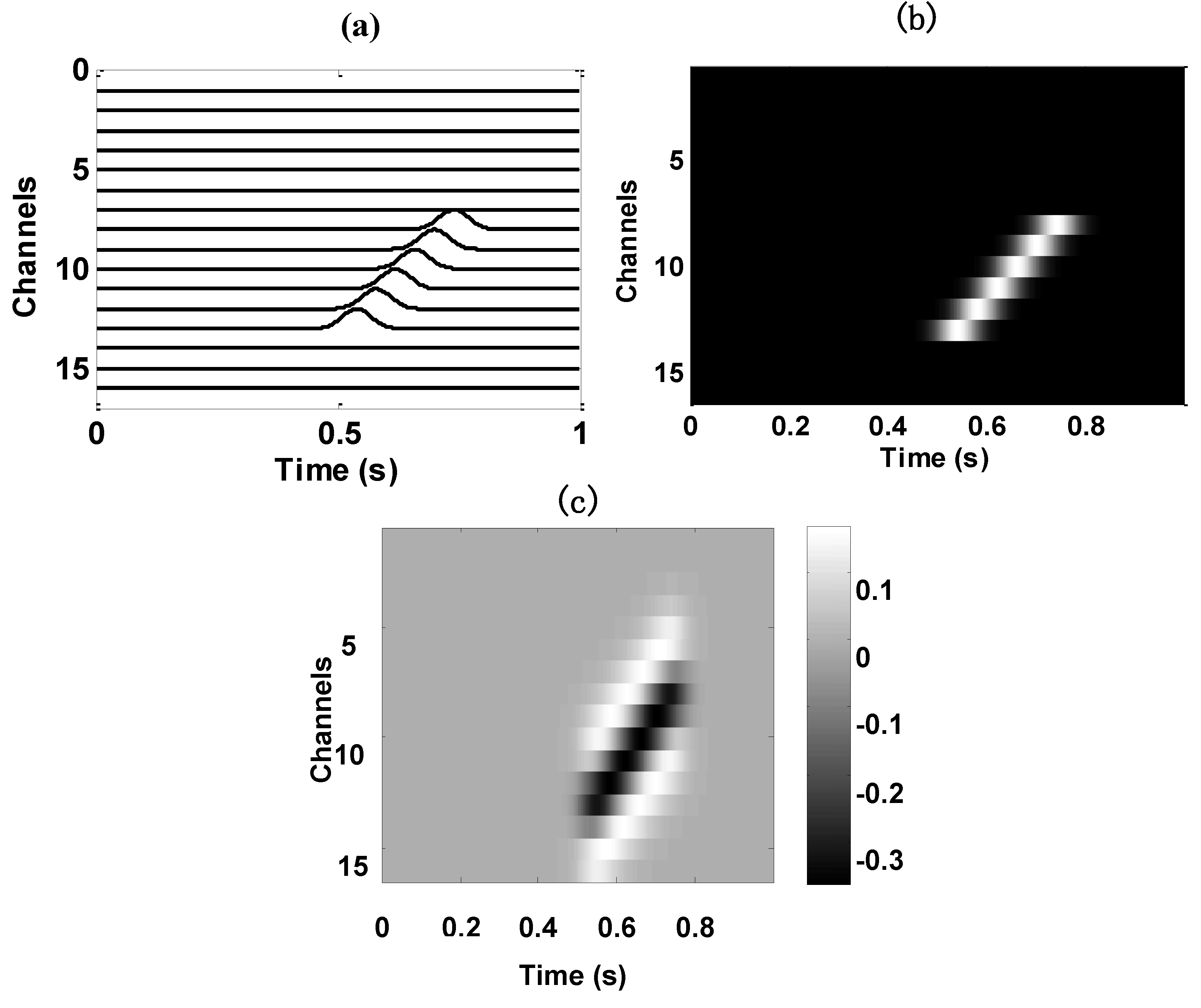
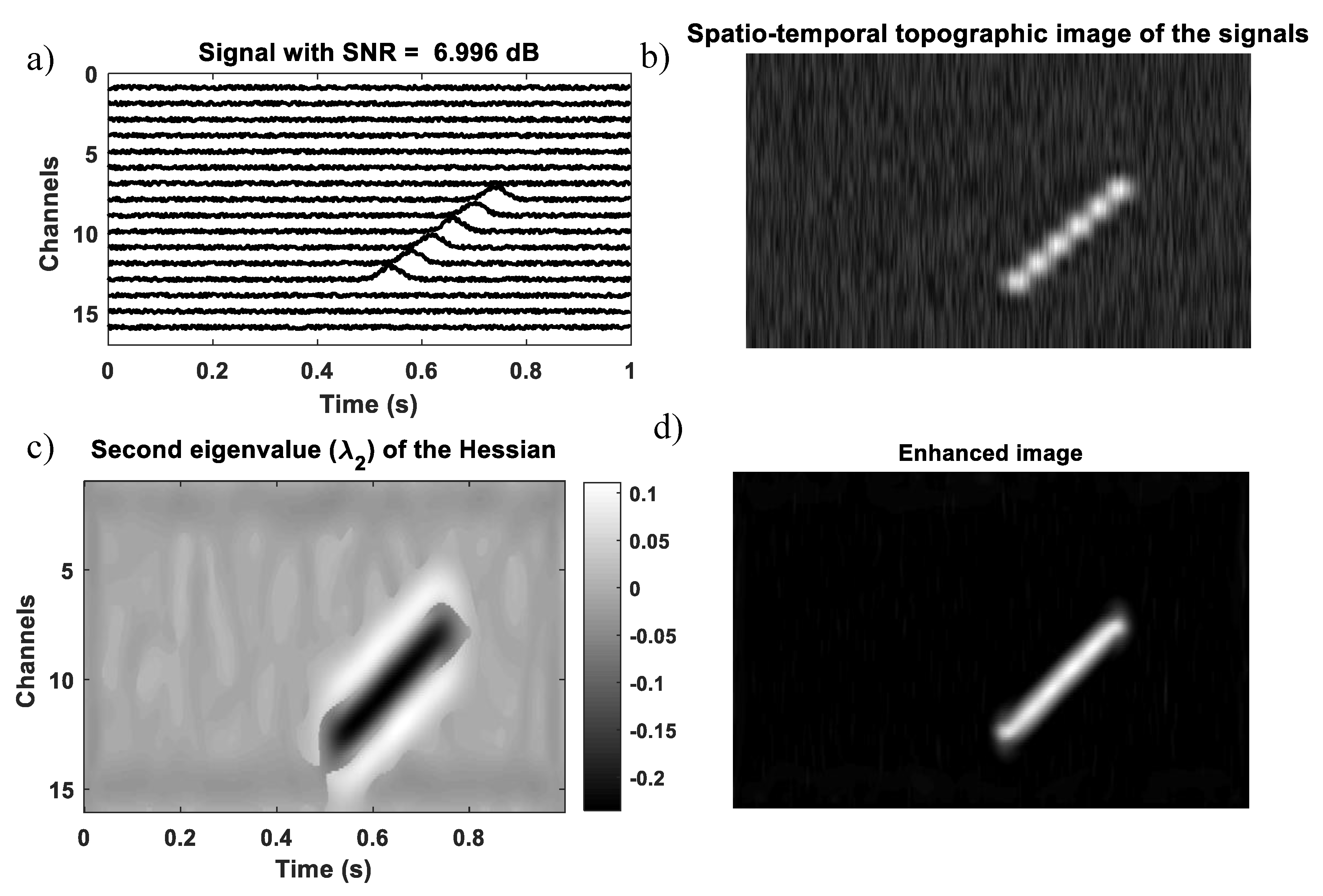
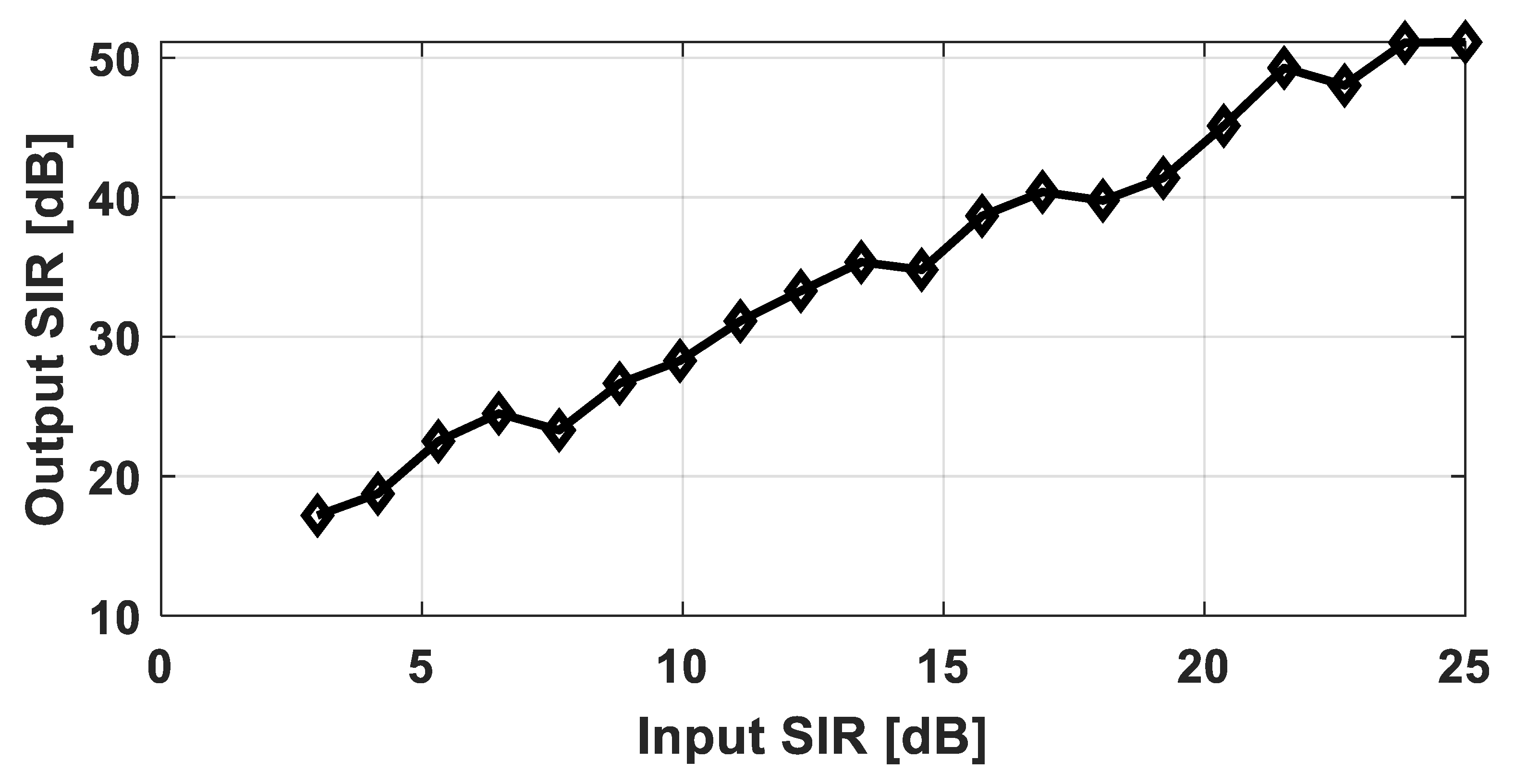
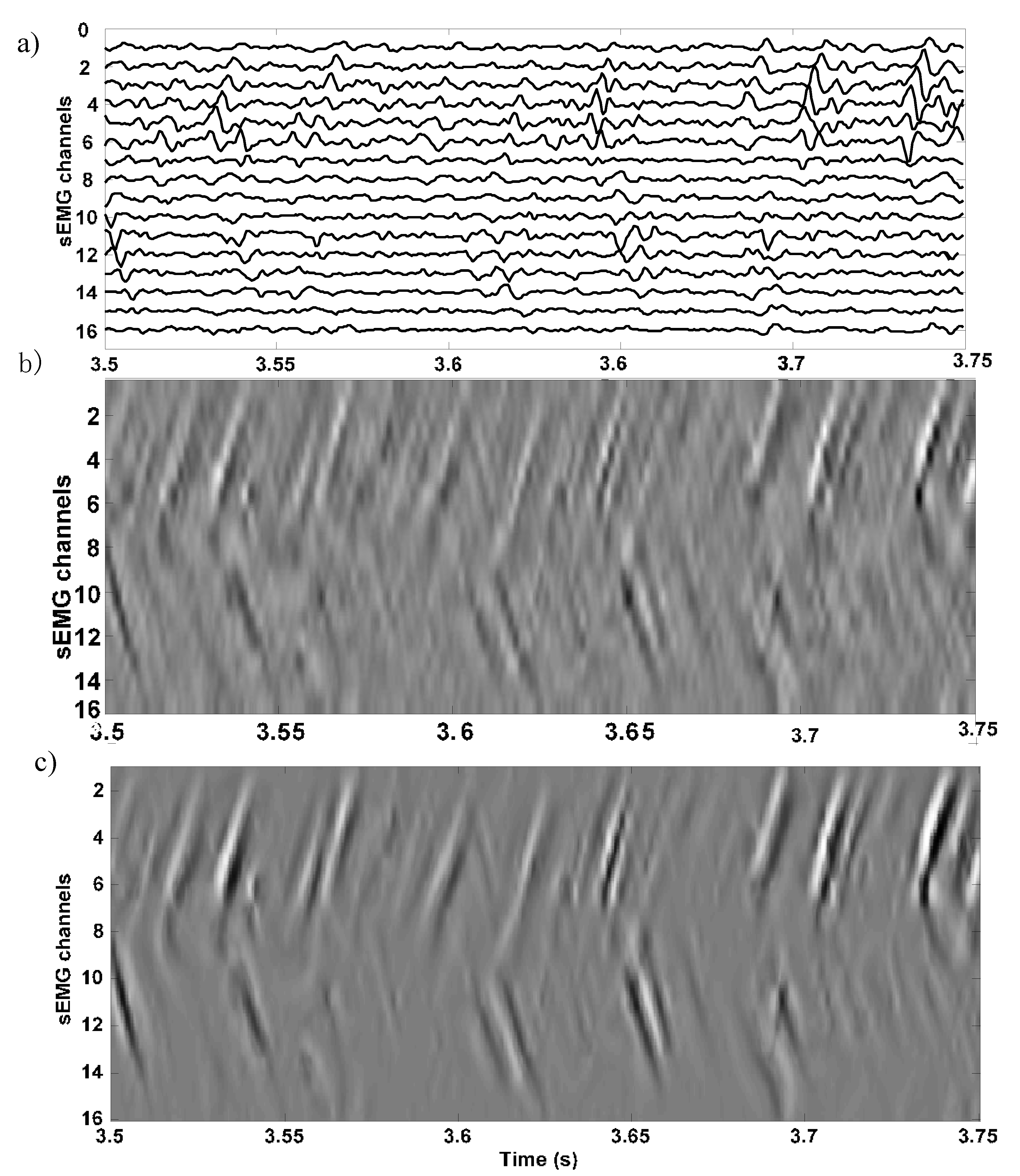
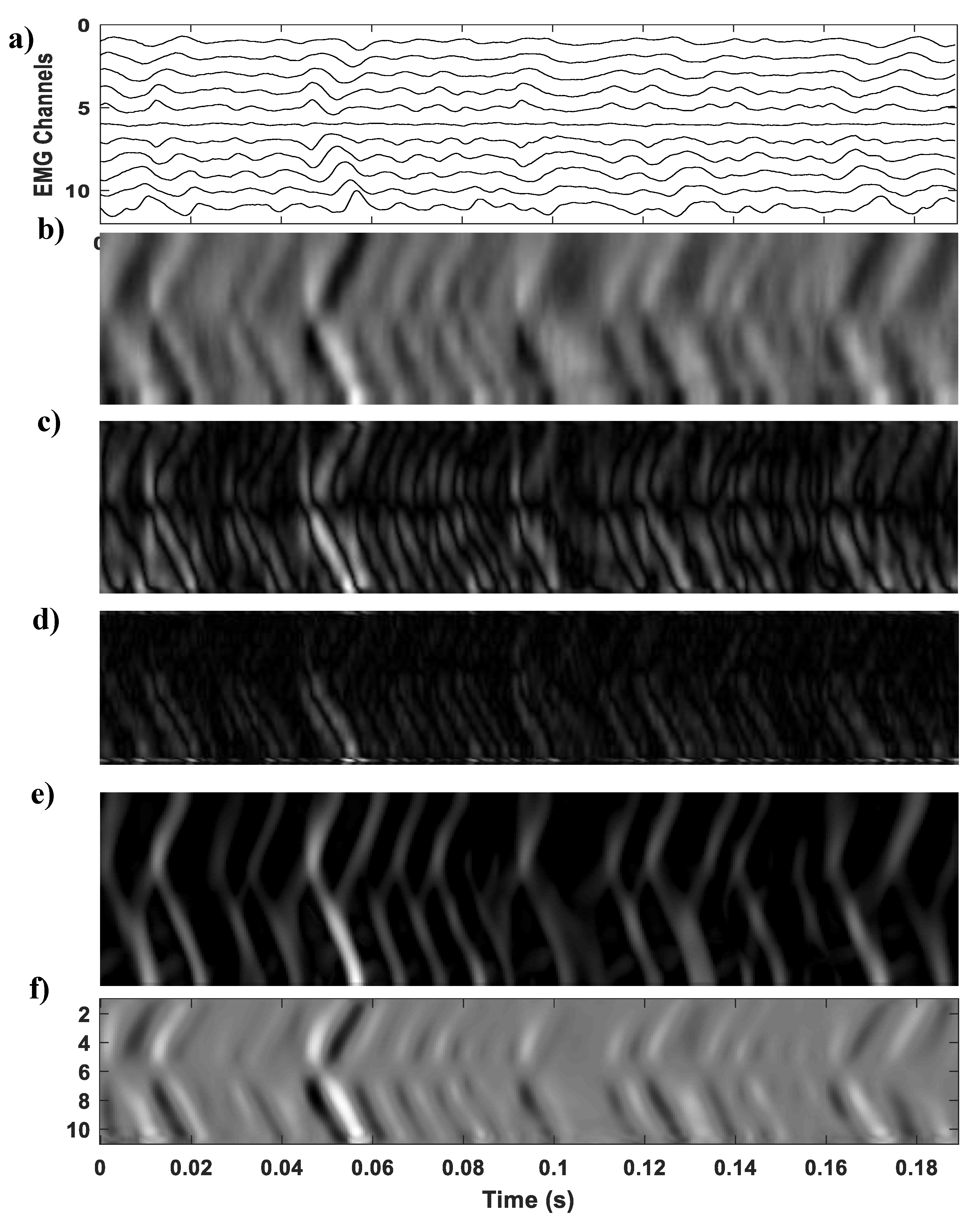
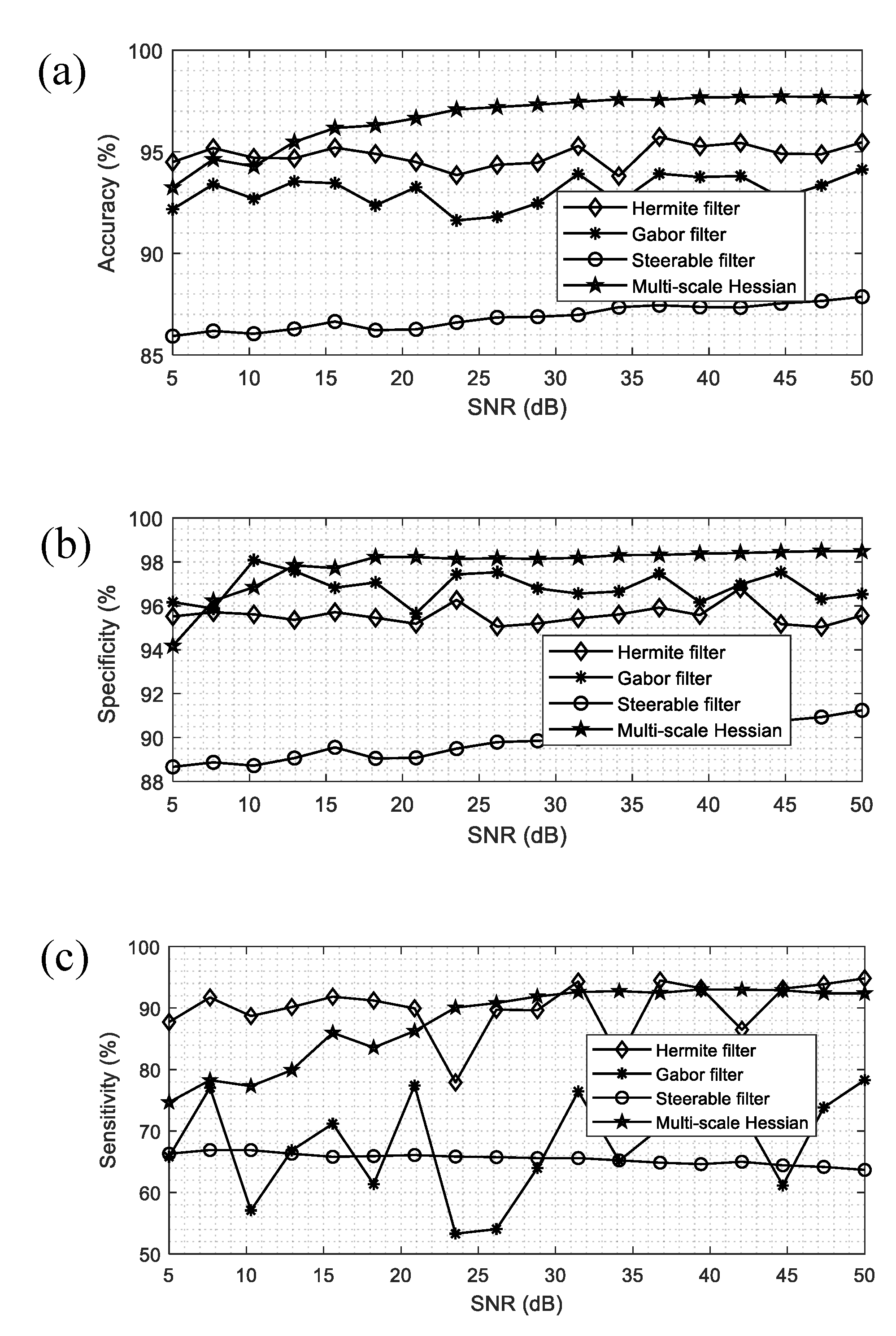
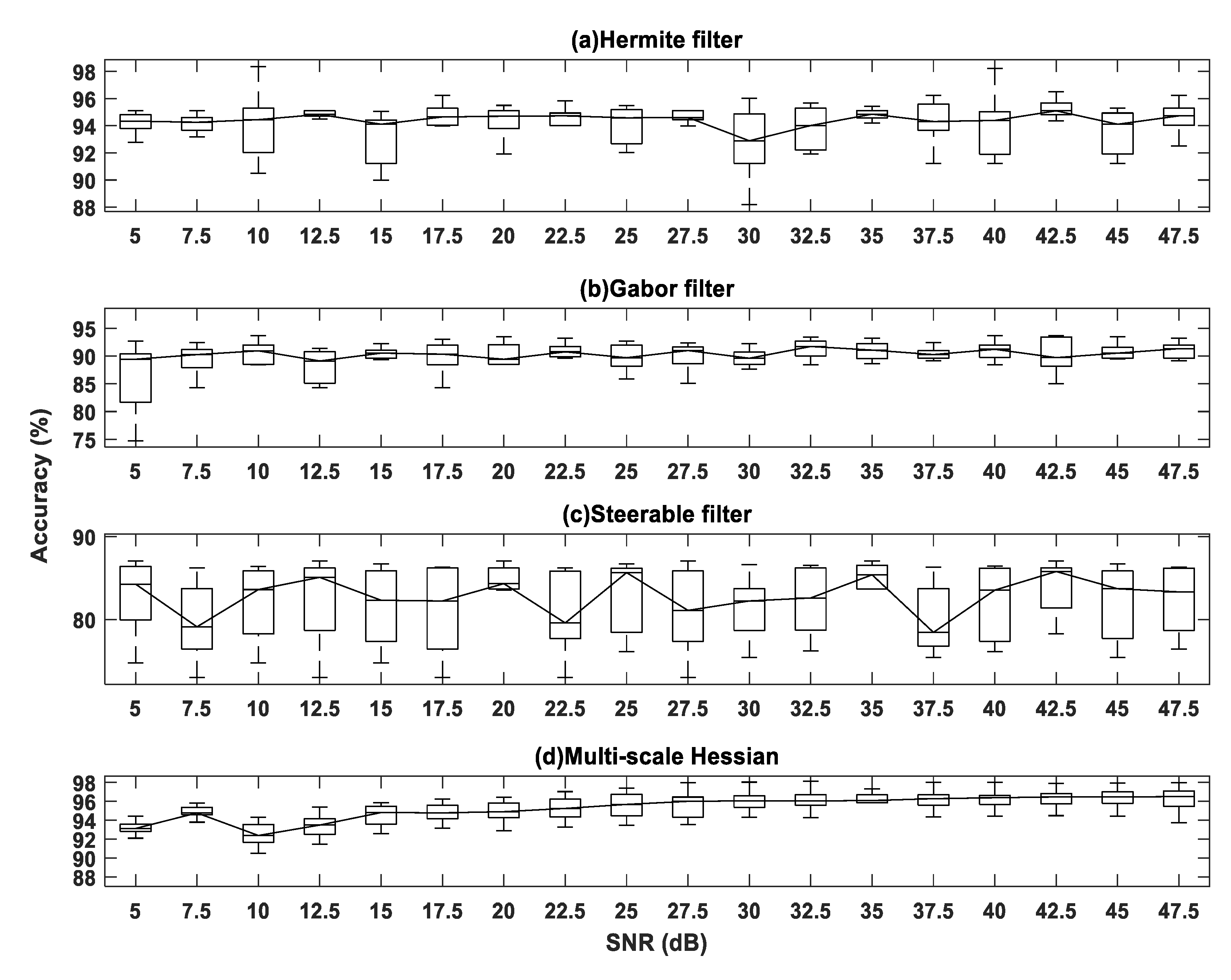
© 2020 by the authors. Licensee MDPI, Basel, Switzerland. This article is an open access article distributed under the terms and conditions of the Creative Commons Attribution (CC BY) license (http://creativecommons.org/licenses/by/4.0/).
Share and Cite
Ullah, K.; Khan, K.; Amin, M.; Attique, M.; Chung, T.-S.; Riaz, R. Multi-Channel Surface EMG Spatio-Temporal Image Enhancement Using Multi-Scale Hessian-Based Filters. Appl. Sci. 2020, 10, 5099. https://doi.org/10.3390/app10155099
Ullah K, Khan K, Amin M, Attique M, Chung T-S, Riaz R. Multi-Channel Surface EMG Spatio-Temporal Image Enhancement Using Multi-Scale Hessian-Based Filters. Applied Sciences. 2020; 10(15):5099. https://doi.org/10.3390/app10155099
Chicago/Turabian StyleUllah, Khalil, Khalil Khan, Muhammad Amin, Muhammad Attique, Tae-Sun Chung, and Rabia Riaz. 2020. "Multi-Channel Surface EMG Spatio-Temporal Image Enhancement Using Multi-Scale Hessian-Based Filters" Applied Sciences 10, no. 15: 5099. https://doi.org/10.3390/app10155099
APA StyleUllah, K., Khan, K., Amin, M., Attique, M., Chung, T.-S., & Riaz, R. (2020). Multi-Channel Surface EMG Spatio-Temporal Image Enhancement Using Multi-Scale Hessian-Based Filters. Applied Sciences, 10(15), 5099. https://doi.org/10.3390/app10155099





